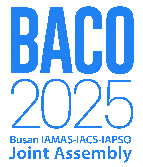Abstract for the Busan IAMAS-IACS-IAPSO Joint Assembly 2025
 Abstract for the Busan IAMAS-IACS-IAPSO Joint Assembly 2025
Abstract for the Busan IAMAS-IACS-IAPSO Joint Assembly 2025
Tropical cloud classification with a clustering analysis applied to CloudSat and CALIPSO observations
Dea Octarina(1), Graduate School of Environmental Studies,Nagoya University
Hirohiko Masunaga(2), Institute for Space-Earth Environmental Research,Nagoya University
Various clouds with different thicknesses and top heights are spread in the tropics, impacting the global climate through their complex radiative properties sensitive to the cloud characteristics such as optical depth. Distinguishing clouds with focus on their respective roles and impacts on the environment is fundamental in climate studies. In this study, tropical cloud fraction from combined CALIPSO and CloudSat observations is classified based on a K-means cluster analysis. These satellite instruments together retrieve detailed vertical structure of clouds, allowing for an objective decomposition of tropical clouds into distinct regimes. The cloud classification is challenged by two sources of uncertainties. The first one is the K-means randomness in selecting the initial cluster centroids. This problem is addressed by repeatedly running the clustering process using different initial guesses, producing multiple clustering solutions. The most proper clustering solution is then determined by evaluating the sum of point-to-centroid distances and frequency of occurrence. The second source of uncertainty arises in this evaluation process that a large sum of point-to-centroid produced by geometrically thin high clouds. Thin clouds with slightly different altitudes can be mathematically distant from one another in the clustering procedure despite their morphological similarity. This significant distance causes artificial multiplication of the high-cloud cluster as the specified number of clusters is increased. It turns out that an excessive number of clusters only generates unrealistic subclasses of high clouds. Objective evaluation metrics indicate that the most appropriate number of clusters is four, where the clusters may be labeled as near clear-sky, low cloud, high cloud, and deep convective regimes. A five-cluster classification is also deemed as reasonable, where a fifth regime of congestus clouds joins the other four regimes practically equivalent to the four-cluster solution. The population of congestus clouds is found to be comparable with the deep convective one. Also, adding a congestus cloud cluster does not disturb other regimes' spatial distribution and radiative properties. The four-cluster solution is the best in a statistical sense, but the five-cluster solutions provide another useful interpretation of the tropical cloud regimes. This study suggests that determining the optimal clustering solutions requires careful interpretation from meteorological perspectives beyond a mere statistical assessment of clustering performance.